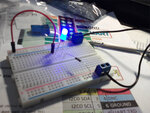KalELonRedKryptonite
Newbie level 4

Hello,
I'm a new student to electronics and I have a question regarding supplying power to a breadboard with a wall adapter.
I took an extra AC to DC wall adapter from an old Blackberry and cut the USB end off of it so I could use the wires. I know the smooth/round wire is the hot wire and the ribbed wire is the neutral wire (output is 5V and 700mA).
I am confused on how to use it to supply power to my breadboard as the way I tried did not light up my LED. I am testing it with a 5mm blue LED, a resistor connected to the negative rail, and a jumper wire to connect the LED to the power rail.
I plugged screw terminal blocks into the positive and negative rails on the breadboard and tried to connect the hot wire to the positive and the neutral wire to the negative but it didn't work. Nothing happened.
So, my question is how do I used this adapter to power my breadboard?
I'm not sure how to make it work. (I do have a Raspberry Pi that I am able to use the GPIO pins to connect to my breadboard to power the LED, but no luck so far with the wall adapter.)
Thank you, I appreciate any help and advice.
I'm a new student to electronics and I have a question regarding supplying power to a breadboard with a wall adapter.
I took an extra AC to DC wall adapter from an old Blackberry and cut the USB end off of it so I could use the wires. I know the smooth/round wire is the hot wire and the ribbed wire is the neutral wire (output is 5V and 700mA).
I am confused on how to use it to supply power to my breadboard as the way I tried did not light up my LED. I am testing it with a 5mm blue LED, a resistor connected to the negative rail, and a jumper wire to connect the LED to the power rail.
I plugged screw terminal blocks into the positive and negative rails on the breadboard and tried to connect the hot wire to the positive and the neutral wire to the negative but it didn't work. Nothing happened.
So, my question is how do I used this adapter to power my breadboard?
I'm not sure how to make it work. (I do have a Raspberry Pi that I am able to use the GPIO pins to connect to my breadboard to power the LED, but no luck so far with the wall adapter.)
Thank you, I appreciate any help and advice.




